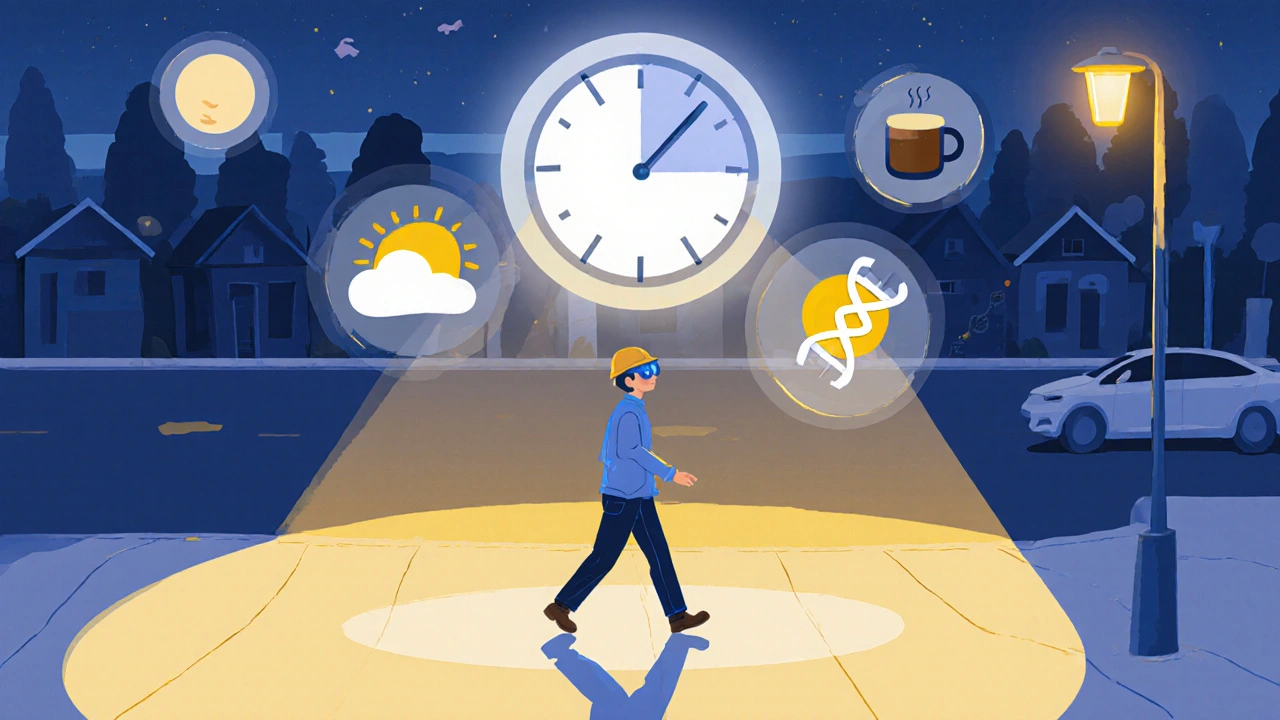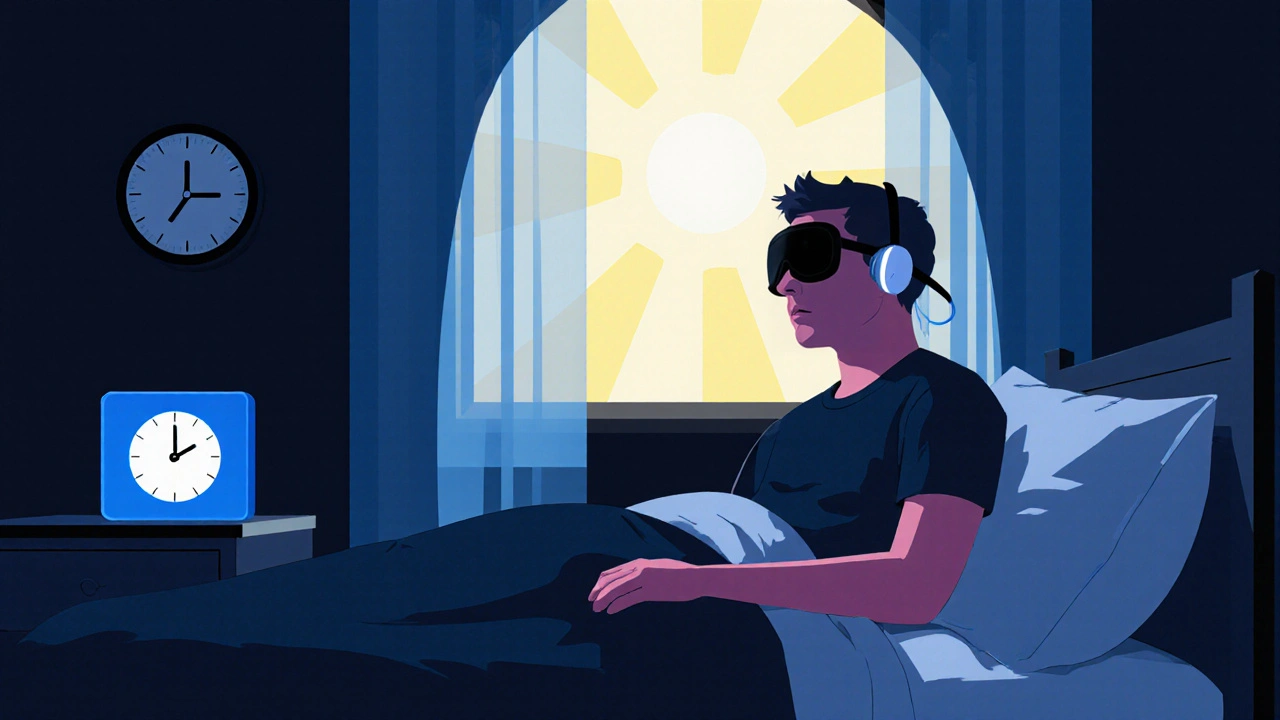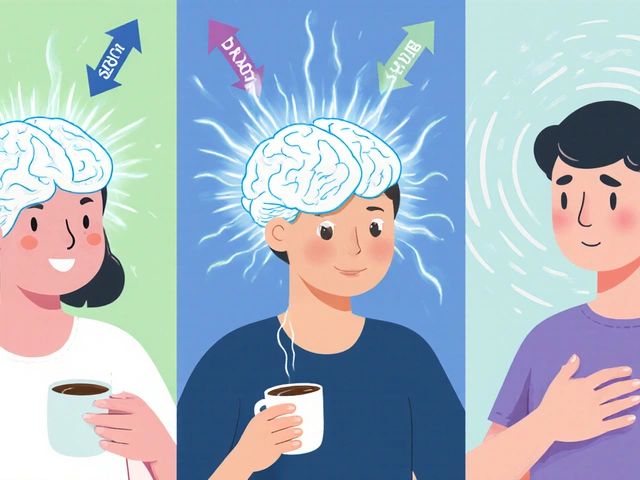Working nights isn’t just inconvenient-it’s physically disruptive. If you’re on the night shift and constantly exhausted, struggling to fall asleep during the day, or nodding off at work, you’re not just tired. You might have shift work sleep disorder (SWSD). This isn’t laziness or poor discipline. It’s a real, medically recognized condition caused by your body’s internal clock being out of sync with your work schedule. And it’s more common than you think.
What Exactly Is Shift Work Sleep Disorder?
SWSD is a circadian rhythm disorder. Your body runs on a 24-hour cycle-melatonin rises at night to make you sleepy, cortisol peaks in the morning to wake you up. When you work nights, your brain still thinks it’s nighttime when you’re supposed to be awake. So you feel groggy on the job. Then, when you try to sleep during the day, your body thinks it’s morning. Light, noise, and your own biology fight against you.
The American Academy of Sleep Medicine defines SWSD as persistent insomnia or excessive sleepiness that lasts at least one month and directly links to a non-traditional work schedule. You don’t need to work every night. Rotating shifts, early mornings, or late evenings can trigger it too. About 10-30% of night and rotating shift workers develop this disorder. In the U.S., over 15 million people are affected. Healthcare workers, factory staff, truck drivers, and emergency responders are hit hardest.
Why Your Body Can’t Adapt
Many people think, “I’ve been on nights for five years-I should be used to it.” But science says otherwise. Dr. Charles Czeisler’s research at Brigham and Women’s Hospital found that only 2-5% of night shift workers ever fully adapt their circadian rhythms. Even after decades, most people’s bodies still produce melatonin during their work hours and cortisol during their sleep hours.
Here’s what happens: Your eyes pick up daylight-even through closed eyelids or curtains-and your brain shuts down melatonin production. That’s why blackout curtains alone aren’t enough. Your body needs total darkness, quiet, and a consistent routine to reset. But even then, your internal clock resists. The suprachiasmatic nucleus (SCN), your brain’s master clock, doesn’t switch easily. That’s why you might sleep for 4 hours, wake up wide awake at 2 p.m., and then feel exhausted again by 8 p.m.
Signs You Have SWSD (Not Just Fatigue)
Everyone gets tired on nights. But SWSD has clear signs:
- Struggling to fall asleep or stay asleep during the day, even when you’re exhausted
- Feeling extremely sleepy during your shift, especially between 4 a.m. and 6 a.m.
- Needing caffeine just to stay awake-but it doesn’t help after 2 a.m.
- Waking up too early (like 5 a.m.) and being unable to go back to sleep
- Having trouble concentrating, remembering things, or making decisions at work
- Feeling irritable, anxious, or depressed more often than usual
- Experiencing digestive issues, headaches, or frequent colds
One nurse in Darwin told me she once fell asleep standing up during a night shift. She didn’t realize it until her colleague tapped her shoulder. That’s not normal tiredness. That’s your brain shutting down because it’s been fighting biology for months.
How SWSD Hurts Your Health Long-Term
It’s not just about feeling bad at work. SWSD increases your risk for serious health problems. The International Agency for Research on Cancer classifies night shift work as “probably carcinogenic.” Studies link it to higher rates of breast cancer, prostate cancer, and colon cancer. Why? Because melatonin, which your body makes at night, helps regulate cell repair and suppresses tumor growth. When you’re awake at night, melatonin drops.
SWSD also raises your risk for:
- Type 2 diabetes (due to insulin resistance from poor sleep)
- Heart disease (higher blood pressure, inflammation, irregular heart rhythms)
- Obesity (disrupted hunger hormones like ghrelin and leptin)
- Depression and anxiety (chronic sleep loss affects serotonin and dopamine)
And it’s not just you. Fatigue from SWSD causes workplace errors. A 2021 case study in Ohio found a night-shift worker caused a $2.3 million equipment failure because he dozed off. The National Safety Council estimates fatigue-related accidents cost U.S. businesses $13 billion a year.

What Actually Works: Evidence-Based Fixes
You can’t fix SWSD with willpower. You need science-backed strategies. Here’s what works, based on guidelines from the American Academy of Sleep Medicine and real-world results:
1. Light Therapy-Your New Best Friend
Use bright light (10,000 lux) during your night shift. Sit near a light box for 30-60 minutes every 2 hours. This tricks your brain into thinking it’s daytime. Studies show it improves alertness by up to 40%. Wear blue-light-blocking glasses on your way home. They filter out the morning sun that tells your brain to wake up. You can get these for under $30 online.
2. Melatonin-Timing Is Everything
Take 0.5 to 5 mg of melatonin 30 minutes before your daytime sleep. Don’t take it before your shift-it’ll make you sleepy on the job. Melatonin helps reset your internal clock. Research from Mayo Clinic shows 65% of shift workers who used it consistently improved their sleep quality within 2-4 weeks.
3. Caffeine-Use It Smart
Drink coffee or tea early in your shift. One cup (100-200 mg caffeine) at the start helps. A second cup halfway through might be okay. But stop after midnight. Caffeine lasts 6-8 hours. If you drink it at 2 a.m., you won’t sleep at 7 a.m.
4. Naps-Short, Strategic, and Powerful
Take a 20-30 minute nap before your shift or during a break. Even a 10-minute nap can reduce errors by 34%. Nurses in a 2021 study reported better alertness and fewer mistakes after using scheduled naps. Don’t nap longer than 30 minutes-it can leave you groggy.
5. Sleep Environment-Treat It Like a Hospital Room
Your bedroom needs to be pitch black, silent, and cool (around 18°C). Use blackout curtains, a white noise machine, and an eye mask. Tell your household you’re sleeping and can’t be disturbed. Put a sign on your door. If you have kids, arrange for someone to handle them during your sleep hours. Sleep quality drops by 50% if there’s any light or noise-even from a TV or phone.
What Doesn’t Work (And Why)
Many people try these-and they fail:
- “I’ll sleep more on my days off.” That just makes your schedule worse. Your body needs consistency. Sleeping 10 hours on Saturday and then going back to nights on Sunday confuses your rhythm even more.
- “I’ll just drink more coffee.” Caffeine doesn’t fix sleep debt. It just masks it. You’ll crash harder later.
- “I’ll go to bed earlier on work nights.” If you go to bed at 9 p.m. and wake up at 1 a.m., you’re still sleeping during your body’s natural wake time. Your brain won’t let you sleep deeply.
- “I’ll use sleeping pills.” Prescription sleep aids don’t fix circadian misalignment. They may help you fall asleep, but they don’t improve sleep quality or help your body adapt.
Chronotypes Matter-Are You a Night Owl or a Morning Lark?
Not everyone adapts the same way. Your chronotype-your natural sleep-wake preference-matters. People who are naturally “night owls” (they feel most alert in the evening) adapt to night shifts 37% better than “morning larks.” If you’ve always been a late sleeper, nights might suit you better. If you’re the type who wakes up at 5 a.m. without an alarm, nights will be brutal.
There’s no test you need to take. Just ask yourself: When do I naturally feel most alert? When do I feel sleepy without caffeine? That’s your chronotype. Use it to plan your schedule. If you’re a morning person, try to avoid permanent nights. Rotate shifts instead, so you get some daylight exposure.
Employers Aren’t Helping-But You Can Still Advocate
Only 22% of shift workers have access to quiet, dark sleeping spaces at work, according to NIOSH. Most employers don’t offer light therapy devices, flexible scheduling, or SWSD education. But you can push for change.
Bring data to your manager: “SWSD costs companies $5.20 for every $1 spent on prevention.” Point them to the CDC’s NIOSH Shift Work Toolkit. Suggest a pilot program: install light boxes in the break room, allow short naps during breaks, or rotate shifts more slowly (no more than 3 consecutive nights).
If your workplace refuses, know your rights. In the EU, workers can’t do more than 4 night shifts in a row. In the U.S., OSHA recommends fatigue management plans for safety-sensitive jobs. You’re not asking for special treatment-you’re asking for safety.

When to See a Sleep Specialist
If you’ve tried these strategies for 4-6 weeks and still can’t sleep or stay awake, see a sleep doctor. They can:
- Order a sleep study or actigraphy monitor to track your sleep patterns
- Confirm if it’s SWSD or another disorder like sleep apnea
- Prescribe FDA-approved medications like modafinil or armodafinil (for daytime alertness)
- Recommend timed light therapy devices
The FDA approved sodium oxybate in May 2023 specifically for SWSD-related sleepiness. It’s not a first-line treatment, but it’s an option if other methods fail.
Real People, Real Results
A 42-year-old paramedic in Adelaide switched from 12-hour nights to 8-hour nights with 2 days off in between. She started using a 10,000-lux light box during her shift and took melatonin before her 10 a.m. sleep. Within 3 weeks, she was sleeping 6-7 hours a day. She stopped calling in sick. Her partner said she was “like a different person.”
A warehouse worker in Darwin used strategic naps and blue-light glasses on his commute. He cut his caffeine intake after 1 a.m. and started using a white noise app. His sleep improved from 3 hours to 5.5 hours. He stopped making inventory errors.
These aren’t miracles. They’re science.
What’s Next for SWSD?
Researchers are now testing genetic-based treatments. Some people have variations in the PER3 and CLOCK genes that make them more vulnerable to circadian disruption. In the next 5 years, personalized sleep plans based on DNA may become common.
Wearable tech is also advancing. Companies are rolling out smartwatches that track your melatonin levels and light exposure. By 2025, 68% of major healthcare systems plan to use these for employee health programs.
But right now, the tools you need are already here: light, melatonin, naps, silence, and consistency. You don’t need to wait for the future. Start today.
Final Thought: You’re Not Broken
You’re not lazy. You’re not failing. Your body is doing exactly what it’s designed to do-it’s trying to sleep when it’s dark and be awake when it’s light. The problem isn’t you. It’s a schedule that ignores biology.
Managing SWSD isn’t about fixing yourself. It’s about working smarter with your biology. You can’t change your shift. But you can change how you respond to it. Start with one thing: tomorrow, wear those blue-light glasses on your way home. Block the sun. Give your brain a signal: it’s time to sleep. Small steps, done consistently, change everything.
Can you fully adapt to night shifts?
Only 2-5% of night shift workers ever fully adapt their circadian rhythm, even after years on the schedule. Most people’s bodies continue to produce melatonin during work hours and cortisol during sleep hours. This means you’ll always be fighting your biology to some degree. The goal isn’t full adaptation-it’s minimizing the damage with smart strategies.
Is SWSD the same as insomnia?
No. Insomnia is trouble sleeping regardless of schedule. SWSD is specifically tied to work hours that conflict with your natural sleep cycle. You might sleep fine on weekends but struggle on nights. If your sleep problems only happen when you work nights or rotating shifts, it’s likely SWSD, not general insomnia.
How long should I nap during a night shift?
A 20-30 minute nap is ideal. Shorter naps boost alertness without causing grogginess. Longer naps (over 45 minutes) can lead to sleep inertia, leaving you more tired when you wake up. Nap before your shift or during a break-never right before you’re about to go home to sleep.
Should I take melatonin every night?
Yes-if you’re on a consistent night schedule. Take it 30 minutes before your daytime sleep. Don’t take it on days off unless you’re trying to reset your rhythm. Melatonin is a signal, not a sedative. It tells your brain it’s time to sleep. Over time, your body may respond better to it. Stick with the same dose (0.5-5 mg) for consistency.
Why do I feel worse on days off?
Because your body is still stuck in night mode. On days off, you might sleep late, get sunlight in the afternoon, or go out in the evening. This delays your circadian reset. To avoid this, try to keep your sleep schedule as close as possible-even on days off. Sleep at the same time, wake at the same time, and use light therapy or darkness to maintain the rhythm.
Can SWSD lead to permanent sleep problems?
Yes, if left unmanaged. Chronic circadian disruption can lead to long-term sleep disorders, even after you stop working nights. Studies show people who worked nights for over 10 years often struggle with insomnia or irregular sleep patterns for years afterward. The earlier you manage SWSD, the less likely you are to develop lasting damage.


